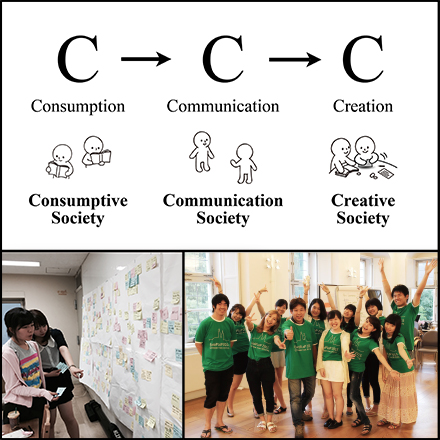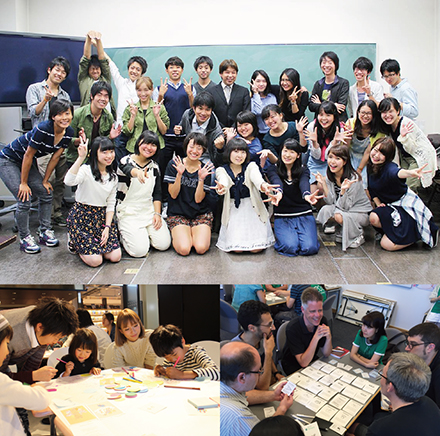Seminar Syllabus: Iba Lab B (GIGA), 2016 Spring
From 2016, we will be offering Iba Lab B (GIGA) in English !!!
See also Iba Lab A (in Japanese).
Iba Lab B (GIGA)
Exploring Creativity, Collaboration, and Pattern Languages
(Thursday 3rd period, 2016 Spring semester)
Feb 29th: Entry submission deadline
March: Interview sessions

Purpose
Our society is becoming more complex and diverse day by day. Finding a way to design the future with our own hands has become the fundamental problem for us today. To be creative in such a society, we must create our own visions, and design tools and methods to make those visions a reality.
In our lab, we define a “Creative Society” as a society where people create their own goods, tools, concepts, knowledge, mechanisms, and ultimately the future with their own hands. Creation in this society is no longer limited to just companies and organizations, but is entrusted to each and every individual. In such a creative society, pattern languages are key media for supporting creative acts. A Pattern Language is a collection of information called “patterns,” which together works in a language-like structure to scribe out the practical knowledge related to a certain field of knowledge.
The lab aims to seize the sprouts of the creative society, imagine its growth, and nurture it through actual practice. Members of the lab would either work on his/her own project based on their interests in a certain field, or they can work in one of the frontier projects offered by the professor. Examples of projects include investigation of new types of education, putting creative pattern-language workshops to practice, sociological analysis of open collaborations, analysis of the creative process, creation of tools to support creative processes, studying cultural differences with using pattern languages, or the creation of a pattern language in a new field. Of course, any other topic that you are interested in is welcome.
Number of Students
15
Requirement
The theme for our lab is Creativity. We are looking for prospective lab members who are willing to commit creatively to the future!
Special Note
We are looking for members who are willing to study together with us in a long perspective. Breakthrough in knowledge and skills can be expected through long-term commitment.
Join us on opportunities to go on overseas trips to attend workshops and academic conferences. This year we will be visiting Taiwan in February, Italy in June, Germany in July, and the US in October.
Screening Schedule
Feb 29th: Entry submission deadline
March: Interview sessions
Assignment
After reading through this syllabus thoroughly, please submit the entry assignment described below via email by Feb 29th.
Email to: ilab-entry [at] sfc.keio.ac.jp
Subject: Iba Lab B (2016 Spring) Entry
Please attach your entry assignment in a Word, Pages or PDF file.
Iba Lab B (2016 Spring) Entry
1. Name, Faculty, Grade, Student ID, login ID
2.Profile photo (for reference to interview session)
3. Topic of study you wish to work on in the lab. Reason for your entry. Your enthusiasm towards the project.
4. Other Labs you are planning on joining next semester (if any)
5. Labs you have been a part of (if any)
6. Favorite classes you've taken so far - Multiple answers are welcome
7. Courses by Prof. Iba which you have taken before (if any)
8. Any other introduction of yourself. (Circles, activities, interests, future visions, any other points to sell)
** You are welcome to use any pictures or diagrams.
The selection interview will be held based on the information given in the entry assignment, in Jan 27 (Wed) -28 (Thur), 2016.
Class Schedule
Progress on each member's project will be shared at lab meetings. In addition, we will discuss books related to our research, and hold writers’ workshops for polishing new pattern languages.
Members are required to work on their projects outside of class time.
Assesment Method
Grading will be based on participation, presentation, and project.
Materials & Reading List
References
Creativity
Collaboration Science
Education, Organization, and Tools
Pattern Languages
Iba Lab patterns
Related Courses
PATTERN LANGUAGE
Contact
ilab-entry [at] sfc.keio.ac.jp
Creative Society Lab: Exploring Creativity, Collaboration, and Pattern Languages
See also Iba Lab A (in Japanese).
Iba Lab B (GIGA)
Creative Society Lab
Exploring Creativity, Collaboration, and Pattern Languages
(Thursday 3rd period, 2016 Spring semester)
Feb 29th: Entry submission deadline
March: Interview sessions

Purpose
Our society is becoming more complex and diverse day by day. Finding a way to design the future with our own hands has become the fundamental problem for us today. To be creative in such a society, we must create our own visions, and design tools and methods to make those visions a reality.
In our lab, we define a “Creative Society” as a society where people create their own goods, tools, concepts, knowledge, mechanisms, and ultimately the future with their own hands. Creation in this society is no longer limited to just companies and organizations, but is entrusted to each and every individual. In such a creative society, pattern languages are key media for supporting creative acts. A Pattern Language is a collection of information called “patterns,” which together works in a language-like structure to scribe out the practical knowledge related to a certain field of knowledge.
The lab aims to seize the sprouts of the creative society, imagine its growth, and nurture it through actual practice. Members of the lab would either work on his/her own project based on their interests in a certain field, or they can work in one of the frontier projects offered by the professor. Examples of projects include investigation of new types of education, putting creative pattern-language workshops to practice, sociological analysis of open collaborations, analysis of the creative process, creation of tools to support creative processes, studying cultural differences with using pattern languages, or the creation of a pattern language in a new field. Of course, any other topic that you are interested in is welcome.
Number of Students
15
Requirement
Special Note
Screening Schedule
Assignment
After reading through this syllabus thoroughly, please submit the entry assignment described below via email by Feb 29th.
Email to: ilab-entry [at] sfc.keio.ac.jp
Subject: Iba Lab B (2016 Spring) Entry
Please attach your entry assignment in a Word, Pages or PDF file.
Iba Lab B (2016 Spring) Entry
1. Name, Faculty, Grade, Student ID, login ID
2.Profile photo (for reference to interview session)
3. Topic of study you wish to work on in the lab. Reason for your entry. Your enthusiasm towards the project.
4. Other Labs you are planning on joining next semester (if any)
5. Labs you have been a part of (if any)
6. Favorite classes you've taken so far - Multiple answers are welcome
7. Courses by Prof. Iba which you have taken before (if any)
8. Any other introduction of yourself. (Circles, activities, interests, future visions, any other points to sell)
** You are welcome to use any pictures or diagrams.
The selection interview will be held based on the information given in the entry assignment, in Jan 27 (Wed) -28 (Thur), 2016.
Class Schedule
Assesment Method
Grading will be based on participation, presentation, and project.
Materials & Reading List
References
- Daniel H. Pink, A Whole New Mind: Why Right-Brainers Will Rule the Future, Riverhead Trade, 2006
- R. Keith Sawyer, Explaining Creativity: The Science of Human Innovation, 2nd Edition, Oxford University Press, 2012
- Mason Currey, Daily Rituals: How Artists Work, Knopf, 2013
- Carolyn Fleming, Jack Fleming, Thinking Places: Where Great Ideas Were Born, Trafford Publishing, 2007
- Daniel Goleman & Peter Senge, The Triple Focus: A New Approach to Education, more than sound, 2014
- Peter M. Senge, C. Otto Scharmer, Joseph Jaworski, Betty Sue Flowers, Presence: Human
- Purpose and the Field of the Future, Crown Business, 2008
- C. Otto Scharmer, Theory U: Leading from the Future as It Emerges: The Social Technology of Presencing, Berrett-Koehler, 2009
- Joseph Jaworski, Source: The Inner Path of Knowledge Creation, Berrett-Koehler Publishers, 2011
- Takashi Iba, "An Autopoietic Systems Theory for Creativity", Procedia - Social and Behavioral Sciences, Vol.2, Issue 4, 2010, pp.6610-6625
- Peter Gloor, Scott Cooper, Coolhunting: Chasing Down the Next Big Thing, AMACOM, 2007
- Peter Gloor, Coolfarming: Turn Your Great Idea into the Next Big Thing, AMACOM, 2010
- Keith Sawyer, Group Genius: The Creative Power of Collaboration, Basic Books, 2008
- Niklas Luhmann, Social Systems, Stanford University Press, 1996
- Etienne Wenger, Communities of Practice: Learning, Meaning, and Identity, Cambridge University Press, 1999
- Matthew Lipman, Thinking in Education, 2nd Edition, Cambridge University Press, 2003
- Ikujiro Nonaka, Hirotaka Takeuchi, The Knowledge-Creating Company: How Japanese Companies Create the Dynamics of Innovation, Oxford University Press, 1995
- Tom Kelley, Jonathan Littman, The Art of Innovation: Lessons in Creativity from IDEO, America's Leading Design Firm, Crown Business, 2001
- Neil Gershenfeld, Fab: The Coming Revolution on Your Desktop -- from Personal Computers to Personal Fabrication, Basic Books, 2007
- Mary Lynn Manns, Linda Rising, More Fearless Change: Strategies for Making Your Ideas Happen, Addison-Wesley Professional, 2015
- James O. Coplien, Neil B. Harrison, Organizational Patterns of Agile Software Development, Prentice Hall, 2004
- Kent Beck, Cynthia Andres, Extreme Programming Explained: Embrace Change, 2nd Edition, Addison-Wesley; 2nd edition, 2004
- Christopher Alexander, The Timeless Way of Building, Oxford University Press, 1979
- Christopher Alexander, Sara Ishikawa, and Murray Silverstein, A Pattern Language: Towns, Buildings, Construction, Oxford University Press, 1977
- Christopher Alexander, Murray Silverstein, Shlomo Angel, Sara Ishikawa, Denny Abrams, The
- Oregon Experiment, Oxford University Press, 1975
- Christopher Alexander with Howard Davis, Julio Martinez, Don Corner, The Production of Houses, Oxford University Press, 1985
- Christopher Alexander, The Nature of Order, BOOK ONE: The Phenomenon of Life, The Center for Environmental Structure, 2002
- Christopher Alexander, The Nature of Order, Book 2: The Process of Creating Life, The Center for Environmental Structure, 2003
- Takashi Iba with Iba Lab, Learning Patterns: A Pattern Language for Creative Learning, CreativeShift Lab, 2014
- Takashi Iba with Iba Lab, Presentation Patterns: A Pattern Language for Creative Presentations, CreativeShift Lab, 2014
- Takashi Iba with Iba Lab, Collaboration Patterns: A Pattern Language for Creative Collaborations, CreativeShift Lab, 2014
- Takashi Iba & Makoto Okada (eds), Iba Lab., and DFJI (Dementia Friendly Japan Initiative), Words for a Journey: The Art of Being with Dementia, CreativeShift Lab, 2015
- Tomoki Furukawazono & Takashi Iba, Survival Language Project, Survival Language: A Pattern Language for Surviving Earthquakes, CreativeShift Lab, 2015
- Eri Shimomukai & Sumire Nakamura with Takashi Iba, Change Making Patterns: A Pattern Language for Fostering Social Entrepreneurship, CreativeShift Lab, 2015
- Kaori Harasawa, Natsumi Miyazaki, Rika Sakuraba, & Takashi Iba, A Tale of Pattern Illustrating, CreativeShift Lab, 2015
- Takashi Iba with Iba Lab, Pattern Illustrating Patterns: A Pattern Language for Pattern Illustrating, CreativeShift Lab, 2015
- Takashi Iba, “Using Pattern Languages as Media for Mining, Analysing, and Visualising Experiences,” International Journal of Organisational Design and Engineering (IJODE), Vol. 3, No.3/4., 2014
Related Courses
PATTERN LANGUAGE
Contact
ilab-entry [at] sfc.keio.ac.jp
Creative Society Lab: Exploring Creativity, Collaboration, and Pattern Languages
井庭研だより | - | -
